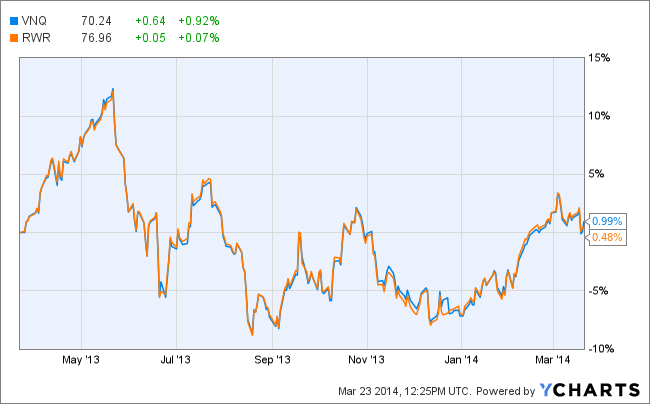One of the big surprises so far in 2014 has been the turnaround in the Real Estate Investment Trust (REIT) market, listed stocks that pay dividends and invest in commercial real estate, such as apartment buildings, office buildings and shopping malls.
The MSCI US REIT Index is up 8.75% so far this year through March 21, compared with the 1.45% gain in the S&P 500 Index (SPX). On top of that, REITs listed on the FTSE NAREIT All Equity Total Return Index currently boast an average yield of 3.58% as of March 21, well above the 2.74% yield on the 10-year Treasury.
Last year, REITs were crushed by worries about higher interesting rates, which raise these firms’ cost of financing and can dampen activity in the commercial real estate sector.
REIT exchange traded funds such as the Vanguard REIT Index (VNQ) and the SPDR Dow Jones REIT (RWR) experienced sharp declines last May, when the Federal Reserve first hinted that it may start to dial back on its $85 billion in monthly bond prices, which could place upward pressure on rates.
Yet overall REITs have staged a comeback this year. Why? So far at least, the prospect of higher interest rates in 2015 and the Fed’s reduction in monthly bond purchases haven’t hurt the commercial property market.
According to the National Association of Real Estate Investment Trusts (NAREIT), commercial property transactions have recovered to a $30 billion monthly rate, ahead of the pace during 2005 and 2006, but still below the market peak in 2007.
Another sign of confidence in the commercial property sector is the uptick in banking lending. After years of declines, NAREIT points out, bank lending for construction and property development is growth at a 7.8% annual clip.
True, there is no guarantee the REIT rebound will last. Also, the recovery in 2014 in many cases hasn’t made up for the big declines in 2013 as in the case of two big agency mortgage REITs: Annaly Capital Management (NLY) and American Capital Agency Corp. (AGNC).
Still, this asset class does have some advantages for investors in search of yield this year. As John Waggoner at USA Today points out:
“By law, REITs have to pay out at least 90% of their taxable income to shareholders in the form of dividends. As a result, REIT yields tend to be higher than most ordinary stock dividends and higher than most 10-year treasury yields.”
Also, the assumption that a rising interest rate environment is always bad for REITs isn’t supported by the historical data. Morningstar analyst Abby Woodham in a recent report analyzed past periods in which interest rates rose and the performance of this asset class. Aside from interest rates, REITs are also tied to the overall health of the property market and U.S. economy.
Between June 2004 and August 2006, as the Fed raised rates, REITs advanced 65% vs. 21% for the S&P 500. “Higher rates were offset by the surging housing market and broad gains in the equity market at large,” wrote Woodham.
Intrigued by the REIT market or interested in other ideas to lock in yield? Check out the Covestor investment guide on generating income in 2014.
Photo Credit: country_boy_shane
DISCLAIMER: The investments discussed are held in client accounts as of February 28, 2013. These investments may or may not be currently held in client accounts. The reader should not assume that any investments identified were or will be profitable or that any investment recommendations or investment decisions we make in the future will be profitable. REITs may be affected by economic conditions including credit and interest rate risks, as well as risks associated with small- and mid-cap investments. Past performance is no guarantee of future results.





